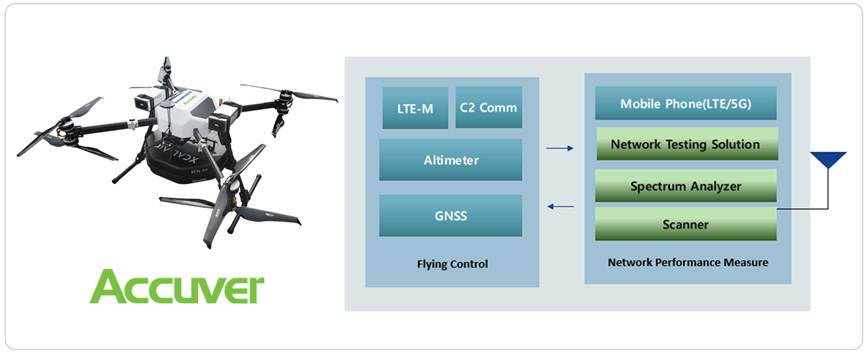Drone-based Airspace Network Test Solution, XCAL-Air
Airspace Network in 5G
The development of a unified network infrastructure integrating Non-Terrestrial Network (NTN) platforms within the scope of 5G and future 6G technology is currently in progress. Standardization organizations like 3GPP are actively working on defining communication standards specifically tailored for Unmanned Aerial Vehicles (UAVs). Efficient performance testing and optimization of airspace networks are crucial to ensure seamless integration of communication services with UAV operations.
The implementation of an airspace network in 5G technology presents unique considerations and challenges compared to traditional terrestrial networks
Weak signal power from base stations to UAVs:
Terrestrial networks are primarily optimized for User Equipment (UE) operating at heights ranging from 1 to 2 meters above ground level (AGL). Radio waves propagating skywards experience a decrease in signal strength compared to the ground. Establishing communication with UAVs may require the use of supplementary base stations or antenna uptilting techniques.
Impact of UAV communication on ground users:
Radio waves emitted by UAVs can extend to distant areas and potentially interfere with nearby base stations, smartphones, and other devices. Ensuring minimal interference and maintaining the quality of service for ground users is a critical challenge.
New use cases :
With the ongoing deployment of NR (New Radio) mobile networks, novel use cases will emerge as UAVs enter the market and leverage the ultra-high speed, large-capacity, ultra-reliable, low-latency communications, and multiple simultaneous connection features offered by NR.
Overcoming these challenges requires optimizing signal strength for UAVs, mitigating interference with ground users, and exploring new use cases enabled by the capabilities of NR. Efforts by standardization organizations and the industry as a whole aim to address these challenges and pave the way for seamless integration of airspace networks within the 5G ecosystem.
South Korea Usecase
UAM Grand Challenge Korea
The deployment and optimization of 5G airspace networks in Korea are driven by the objective of facilitating the commercialization of Urban Air Mobility services by 2025. To ensure a reliable and robust network infrastructure at altitudes ranging from 300 meters to 600 meters above the ground, Korean operators are employing dedicated gNBs and implementing antenna tilting and beam pattern optimization techniques. These strategies aim to provide seamless connectivity, enhanced signal strength, and reduced latency for UAM operations, thus supporting the realization of a safe and efficient urban air transportation ecosystem.
Accuver Airspace Network Test Solution
XCAL-Air

XCAL-Air is an advanced and comprehensive package specifically developed for measuring and analyzing the performance of airspace networks. It is designed to effectively identify and rectify coverage gaps to ensure optimal network performance in airspace environments. This technologically advanced solution incorporates various network equipment, including spectrum analyzers, scanners, and mobile network measurement devices. It offers a comprehensive set of features to enable efficient network verification in airspace environments.
[ Key Features of XCAL-Air ]
Airspace Network Performance Measurement:
XCAL-Air provides a range of powerful measurement capabilities to assess the performance of airspace networks.
It captures and analyzes various network parameters such as signal strength, signal quality, throughput, latency, and other key performance indicators (KPIs) in real-time.
These measurements help in evaluating the network's coverage, capacity, and overall performance, enabling operators to identify areas of improvement.
Integration with XCAL-Manager Air:
The measured data collected by XCAL-Air is seamlessly transferred to XCAL-Manager Air for further analysis and evaluation.
XCAL-Manager Air is a centralized management platform equipped with advanced analytics tools, allowing for in-depth assessment of airspace network performance.
Accurate Global Navigation Satellite System (GNSS) information is associated with the measured data, facilitating precise location-based analysis of airspace network performance.
[ Benefits of XCAL-Air ]
Comprehensive Performance Analysis: XCAL-Air provides a comprehensive set of measurements, enabling operators to gain valuable insights into the performance of airspace networks.
Coverage Gap Identification: By analyzing the collected data, XCAL-Air identifies coverage gaps and areas with suboptimal network performance, allowing operators to take corrective actions.
Real-Time Monitoring on 3D Map: The solution offers real-time monitoring capabilities, providing operators with immediate visibility into network performance and enabling proactive troubleshooting.
Data-Driven Decision Making: XCAL-Air's integration with XCAL-Manager Air enables operators to perform advanced analytics and make data-driven decisions for optimizing airspace network performance.
XCAL-Manager Air
The XCAL-Air Ground Management System comprises two key components: XCAL-Manager Air and DROW4D. These components work in tandem to control and schedule remote tests for XCAL-Air, a specialized network testing tool designed for airspace networks. The XCAL-Air ground management system ensures efficient management, analysis, and verification of network performance.
